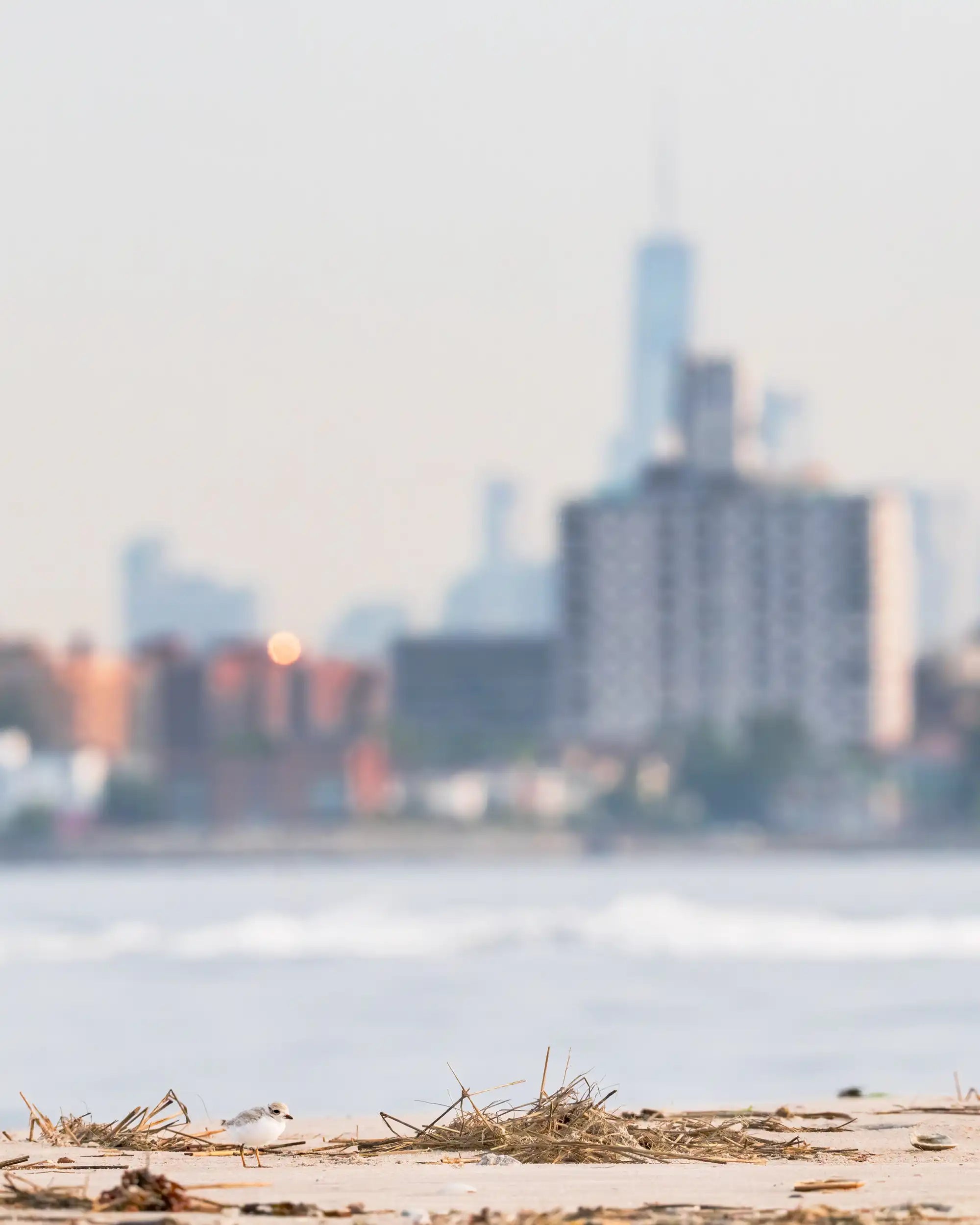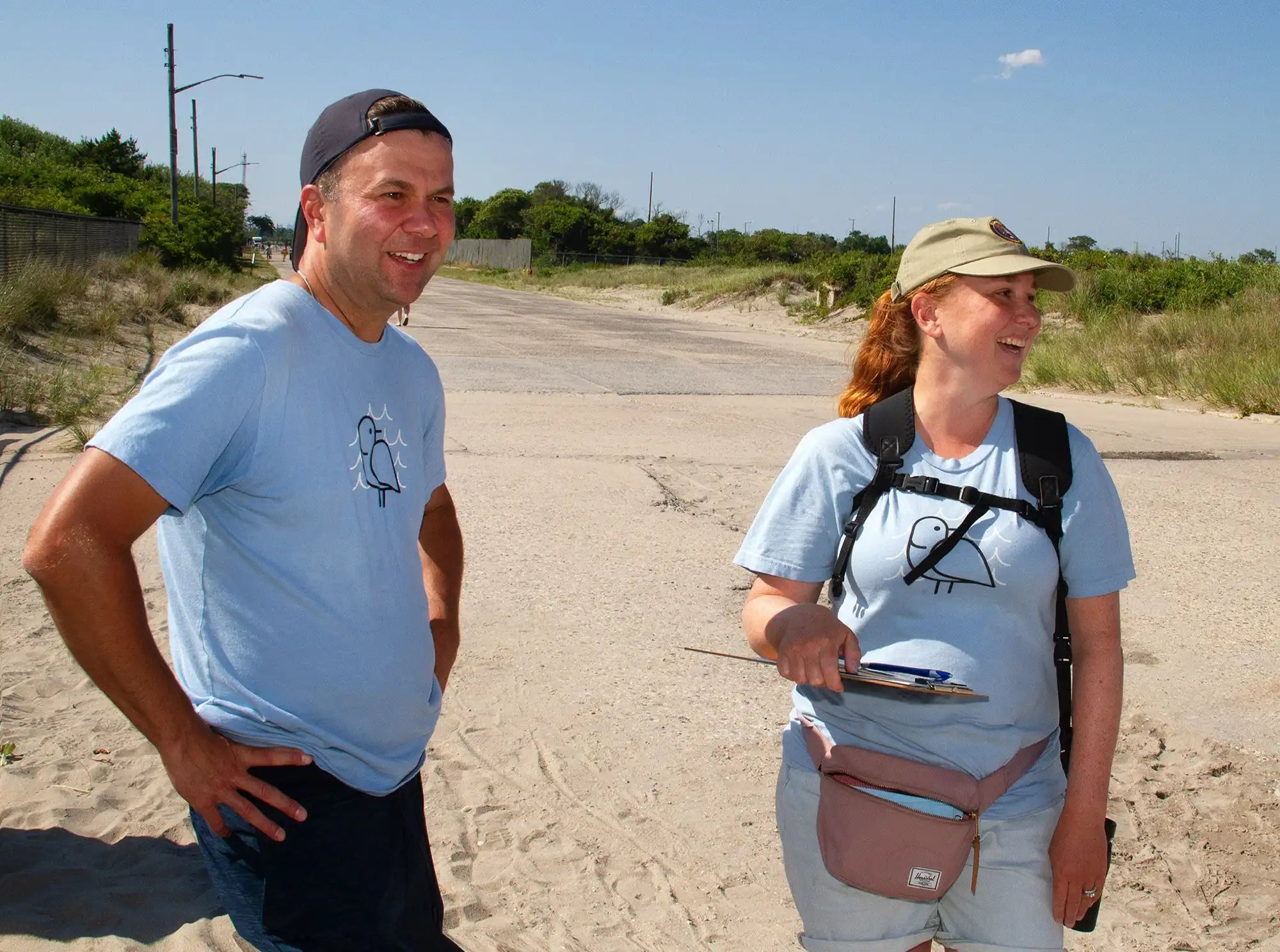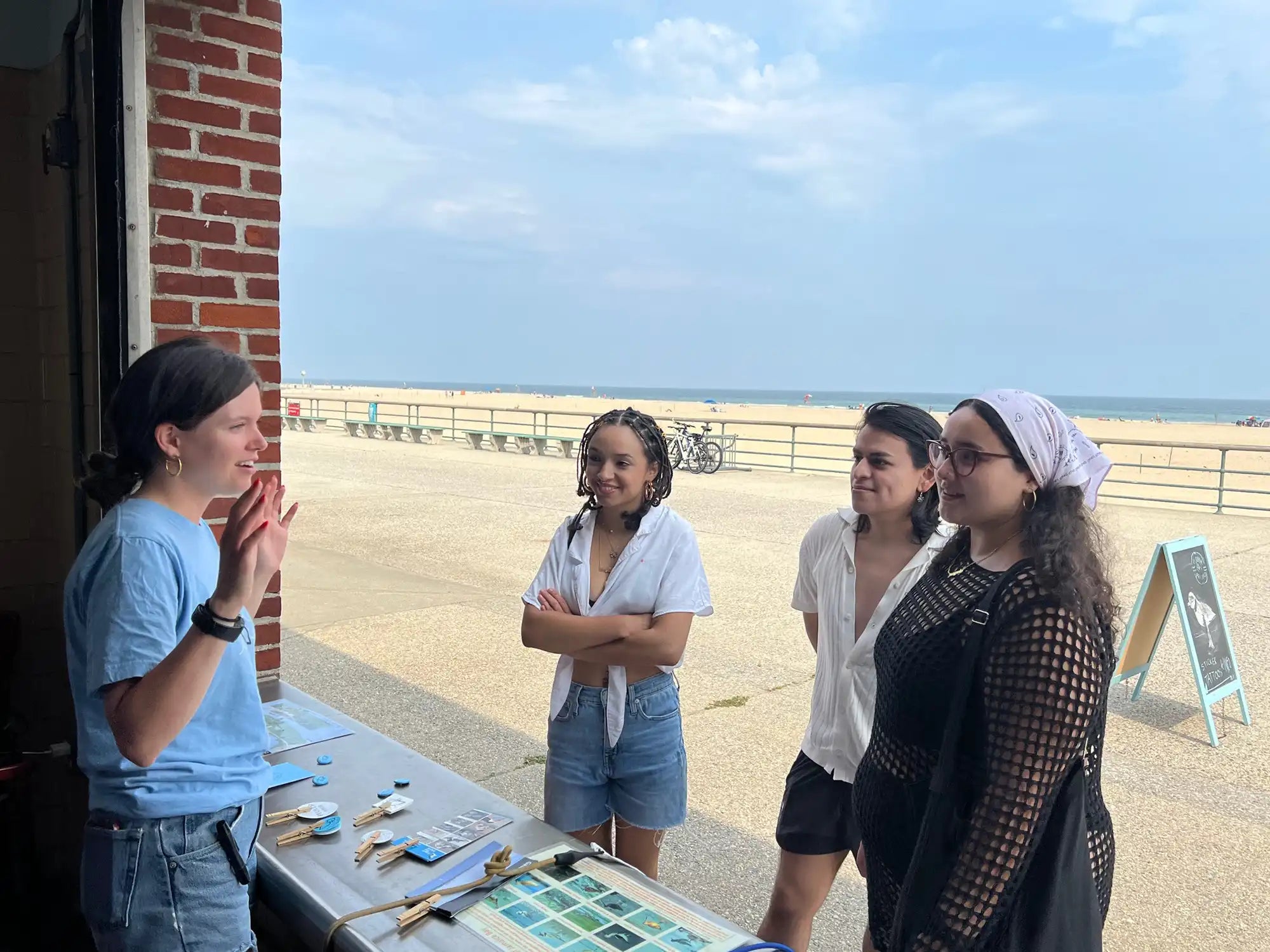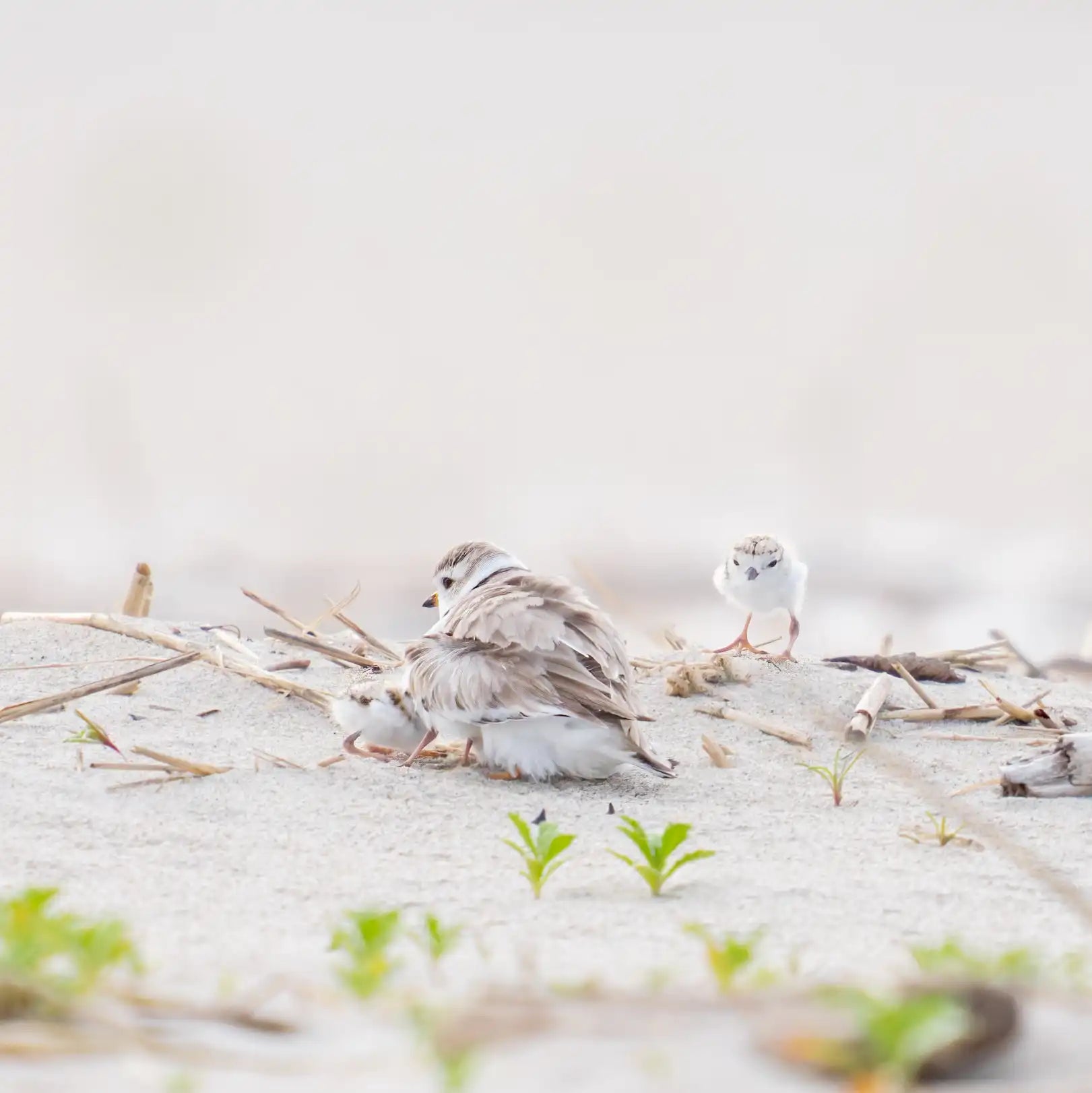
A Piping Plover chick. Photo by Chris Alieri.
NYC Plover Project

A fledgling Piping Plover with the Lower Manhattan skyline in the background. Photo by Benjamin Forbes.
On the ocean and bay beaches of Queens, New York City, volunteers with the NYC Plover Project wear light blue T-shirts featuring a simplified line drawing of a Piping Plover, the tiny, sand-colored, endangered shorebird. The shirts—and the birds—look cute, but make no mistake: the conservation need for these birds is urgent, and the group is fiercely committed to protecting them. “We’re an army of plover protectors,” says Chris Allieri, who started the group in 2021 after learning about the grave threats these birds face on city beaches where they lay their eggs and raise their young. In just three years, the NYC Plover Project has grown its corps of beach-patrolling volunteers to over 200 people, won grants to hire a growing staff overseeing education, community and volunteer efforts, and received an award from the National Park Service (NPS) and National Park Foundation as the national volunteer group of the year.

NYC Piping Plover volunteers walk the beach, sit by beach closures, and talk to people about the various threats these birds face, not only from human disturbances but also habitat loss, predators, and climate change. Photo by Chris Allieri.

Chris Allieri, the NYC Plover Project founder and executive director, and Jen Kepler, a volunteer. Photo by Shari Romar.
Last year was the 50th anniversary of the Endangered Species Act, one of the most effective wildlife protection laws in the world, and the Piping Plover has been listed on it since 1986. There are three nesting populations: one on the alkali lakes of the northern Great Plains, one on the shores of the Great Lakes and one on the beaches of the Atlantic coast. Around the turn of the last century, hunting plundered their numbers. Before they could stage much of a recovery, widespread development along the Atlantic coast for real estate and recreation robbed them of their required breeding habitat. Roughly 6,000 - 8,000 individuals remain, according to the federal government, with about 50 pairs of the Atlantic population that attempt to breed on a patchwork of federal, city and private beaches of the Rockaway Peninsula in Queens, New York City.
This was news to Allieri until the early spring days of the COVID-19 pandemic, in 2020, when, like many New Yorkers, he took to birding in city parks to escape the grip of lockdown. At Fort Tilden, a popular federally-managed beach and former military base, he saw Piping Plovers for the first time since he’d seen one as a seven or eight-year-old, four decades earlier, through a scope outside his family’s home on the southern Jersey Shore. The situation there was different—the plovers had miles of off-limits beach to roam—whereas at Fort Tilden, they seemed harried on all sides. He watched off-leash dogs chasing plovers, kids climbing the dunes, and people flying kites and drones. The nesting season had officially started, and male Piping Plovers sought to claim nesting territories amidst the dunes. He saw no protection for the birds. How could they survive?

Piping Plover chicks must forage for themselves along the shore. This tiny chick braves the crowds at Fort Tilden beach, Queens, NYC. Photo by Chris Allieri.
He returned the following spring and watched a similar scene unfold, and his frustration moved him to act. An environmental organizer since high school, he had started a public-relations firm in 2016 to work with climate tech startups. He decided to create a citizen-led effort to protect those Piping Plovers, calling it the NYC Plover Project. The organization partnered with the National Park Service. That first summer, in 2021, 35 volunteers joined the effort. It has grown exponentially since then, with volunteers from all over the city, and a following of close to 18,000 people on Instagram. The group is now entering its fourth year of partnership with NPS and its second with NYC Parks & Recreation.
The Piping Plover is the only federally listed protected shorebird species under the Endangered Species Act to breed in New York City. As beach-nesting birds, they require constant vigilance, and their reproductive success has never been very good in the city. A Piping Plover clutch is usually four eggs, and the federal productivity recovery goal, as required by the Endangered Species Act, is 1.5 fledglings per pair. In New York City in 2022, the rate was 0.2 per pair. It was the worst breeding season ever recorded in the city. The greatest success has come in New England, on the Maine and Massachusetts coast, but those places don’t suffer from the conservation challenges of a city of eight and a half million people. While 2023 saw some positive improvements along some of NYC’s beaches, there is much more work to be done.
Extreme though it may seem, the situation in New York is a microcosm of why the Piping Plover is an imperiled species.

Ciara Fagan, the NYC Plover Project Education Director, shares information about Piping Plovers with beachgoers at Jacob Riis beach, Queens, NYC. Photo by Chris Allieri.
Like most shorebirds, Piping Plovers are ground nesters, laying their eggs in little scrapes on the sand directly on the broad part of the beach. The eggs are camouflaged to blend into the sand, but this strategy becomes less effective with a lot of beachgoers around—it’s easy to inadvertently trample a nest. What makes Piping Plovers more vulnerable than other beach-nesting birds is that their chicks are precocial, meaning that the young must feed themselves. After hatching, the tiny chicks, which weigh less than two garlic cloves, stand on little toothpick legs and begin foraging. There is a lot of parental care, but it doesn’t extend to feeding. And since the water’s edge is where the high-quality marine food lies, the young need access to it for at least a month if they are to fledge and survive. Thus, to adequately protect Piping Plover families, the beach must be closed all the way to the water’s edge.
It’s a reality that oftentimes doesn’t sit well with New Yorkers, who don’t expect to share a city beach. Since its founding, the Plover Project’s volunteers now sit at those closures, walk the beaches, talk to people, and, in rare instances, call U.S. Park Police when there are direct threats to the birds. In the last few years alone, eggs have been stolen and nests vandalized on NYC Parks’ beaches, which are federal crimes. Across all beaches, several of the diminutive chicks have been stepped on by unwary beachgoers. Other threats loom: nocturnal predators, such as racoons and feral cats, prey on eggs and chicks, and the erosion of beaches due to rising sea levels. Compared to other beach-nesting birds on the Atlantic coast, Piping Plovers are relatively short-lived, so the birds that fledge and survive their first migration and first winter, along the Gulf coast or in the Caribbean, only have on average five years to reproduce and thus replace themselves.

A Piping Plover family. Photo by Benjamin Forbes.
Which leaves the work of the NYC Plover Project all the more important. “It’s a dire situation,” says Allieri. “We’re not just going to set up a table and tell people to share the shore. This is hands-on work, and it’s the hardest thing I’ve ever done in my life. I’m inspired by the commitment of our volunteers and the support we receive from many New Yorkers, most of whom have never heard about the plight of Piping Plovers until they meet us.”
This season, the first male Piping Plovers returned in the middle of March, soon followed by the females, and volunteers are already back on the beach, watching their courtship routines, and hoping that, come summertime, beachgoers recognize the importance of protecting this special bird.
“They're worth it,” Allieri tells new volunteers. “They’re worth all the work; the frustration, the setbacks, the flies, the hot weather.”
And we agree.

An adult Piping Plover nicknamed Clark Kent, who has nested on NYC beaches for at least four years. Photo by Benjamin Forbes.
To learn more about the NYC Plover Project, as well as to contribute directly, please visit its website or click the DONATE button below.
The NYC Plover Project, a nonprofit working to protect endangered Piping Plovers and their nesting habitat in New York City. The group's volunteers actively monitor and protect plover nests and families, engaging beach-goers to teach them about the threats these birds face, including human disturbances, habitat loss, predators and climate change.












